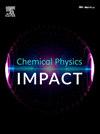One-stop service for perovskite synthesis and characterization by laser trapping
IF 4.3
Q2 CHEMISTRY, PHYSICAL
引用次数: 0
Abstract
Lead halide hybrid perovskites represent a group of compounds exhibiting remarkable potential for applications in solar cells, optoelectronics, and LEDs. Understanding their photophysical properties through scientific techniques is crucial for optimizing their performance in these various fields. In this research our core technique is laser trapping, which utilizes a continuouswave (CW) laser at 800 nm with a power of 0.6 W to manipulate precursor solutions. This focused laser beam allows for trapping-induced crystallization, enabling the formation of high-quality perovskite crystals directly within the measurement setup. Steady-state photoluminescence (PL) measurements are then performed using two-photon excitation at 400 nm using the CW mode of trapping laser. Additionally, photoluminescence lifetime measurements are conducted using the same laser in pulsed mode with picosecond excitation. By analyzing the PL decay over 6 nanoseconds, researchers can gain insights into the excited state dynamics of the perovskite. This work demonstrates the effectiveness of a one-stop approach for perovskite characterization. Laser trapping facilitates controlled crystal growth, while combined steady state PL and PL lifetime measurements provide a comprehensive picture of the material's light-matter interaction. This approach paves the way for efficient and in-depth analysis of novel perovskite materials for next-generation technologies.

一站式服务钙钛矿合成和表征的激光俘获
卤化铅杂化钙钛矿代表了一组在太阳能电池、光电子和led中表现出显著应用潜力的化合物。通过科学技术了解它们的光物理性质对于优化它们在这些不同领域的性能至关重要。在本研究中,我们的核心技术是激光捕获,它利用功率为0.6 W的800 nm连续波激光来操纵前驱体溶液。这种聚焦激光束允许捕获诱导结晶,使高质量钙钛矿晶体的形成直接在测量设置。稳态光致发光(PL)测量,然后使用双光子激发在400 nm使用连续波模式捕获激光。此外,光致发光寿命测量使用相同的激光在脉冲模式下进行皮秒激发。通过分析超过6纳秒的PL衰减,研究人员可以深入了解钙钛矿的激发态动力学。这项工作证明了一站式钙钛矿表征方法的有效性。激光捕获有助于控制晶体生长,而结合稳态PL和PL寿命测量提供了材料的光-物质相互作用的全面图片。这种方法为下一代技术的新型钙钛矿材料的高效和深入分析铺平了道路。
本文章由计算机程序翻译,如有差异,请以英文原文为准。
求助全文
约1分钟内获得全文
求助全文
来源期刊

Chemical Physics Impact
Materials Science-Materials Science (miscellaneous)
CiteScore
2.60
自引率
0.00%
发文量
65
审稿时长
46 days
 求助内容:
求助内容: 应助结果提醒方式:
应助结果提醒方式:


